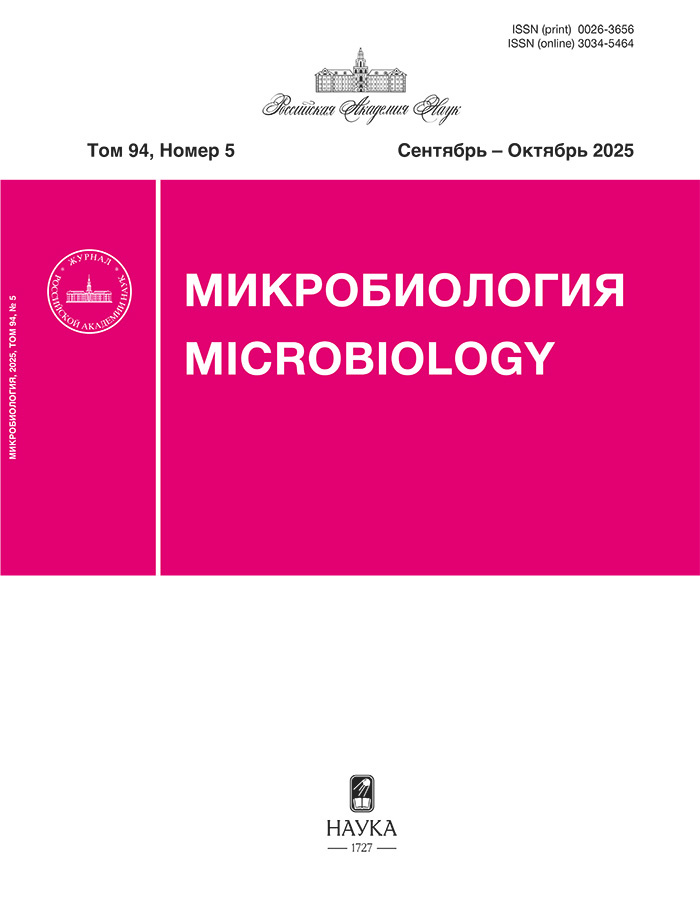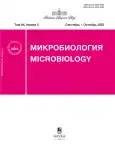Microbiology
ISSN (print):0026-3656
Media registration certificate: No. 0110237 dated 02/09/1993
Founders
- Russian Academy of Sciences
- Institute of Microbiology of the Russian Academy of Sciences
Editor-in-Chief
- Nikolay Viktorovich Pimenov, Doctor of Biological Sciences
Frequency / Access
6 issues per year / Subscription
Included in
White List (2nd level), Higher Attestation Commission List, RISC
最新一期
卷 94, 编号 5 (2025)
REVIEWS
Xerotolerant microorganisms-producers of exopolysaccharides and potential of their use in agricultural technologies
摘要
 363-374
363-374


Bacillus subtilis 26D endophyte – four decades of research and application perspectives
摘要
 375-388
375-388


EXPERIMENTAL ARTICLES
α-Galactosidases and α-N-acetylgalactosaminidases of Planctomycetes: Origin and Genetic Diversity
摘要
 389-397
389-397


Possible role of microbial communities of Lake Baikal bottom sediments in the formation of authigenic siderites abnormally enriched in 13C isotope
摘要
Precipitation of authigenic carbonates during diagenesis of bottom sediments is often a by-product of microbial activity, and the isotopic characteristics of such carbonate minerals are determined by the effects of carbon isotope fractionation during enzymatic reactions. The composition of microbial communities was estimated using the 16S rRNA gene metabarcoding method, and the chemical composition of pore waters of bottom sediments of three mud volcanoes of Lake Baikal containing siderites (FeCO3) anomalously enriched in the 13C isotope (δ13C +7.24…+35.02‰ VPDB), the formation mechanisms of which are currently unknown, were analyzed. The obtained data are consistent with the hypothesis that siderite sedimentation may be associated with local zones of active biogenic destruction of organic matter, but it is suggested that the role of microbial communities in this process may be limited to the reduction of crystalline forms of Fe(III) oxyhydroxides to siderite or replenishment of the Fe(Ⅱ) pool, rather than dissolved inorganic carbon (DIC). In this case, the factor causing the sedimentation of authigenic siderites enriched in the 13C isotope may be the supply of DIC or gaseous CO2 with a deep fluid flow, the isotopic characteristics of which will largely determine the δ13C values of carbonates in the sediments of mud volcanoes of Lake Baikal.
 398-416
398-416


Composition of microbial communities of bottom sediments of the Pechora Sea in the zone of developed oil fields
摘要
 417-425
417-425


Metabolic Potential of Pseudogymnoascus Spp. Fungi
摘要
 426-436
426-436


Altered Sensitivity to UV Light and Radiation in Bacillus Bacteria Exposed to a Hypomagnetic Field
摘要
 437-446
437-446


Intraspecific polymorphism of Saccharomyces paradoxus yeasts: Geographical populations
摘要
In the Siberian Botanical Garden of Tomsk State University, 28 strains of Saccharomyces yeasts were isolated from the bark of Quercus robur and the soil beneath them. Based on the sequencing of the D1/D2 domain and the ITS1 region of rDNA, three strains were assigned to the species S. cerevisiae, and the rest to the species S. paradoxus. Using multigene phylogenetic analysis of nuclear genes (NEJ1, EST2, HDF1, HDF2), the genetic relationship of West Siberian strains of S. paradoxus with European, Far Eastern, North American and Hawaiian populations was studied. According to the results obtained, the West Siberian strains belong to the European population. Apparently, the border between the European and Far Eastern populations of S. paradoxus lies east of Tomsk Oblast.
 447-460
447-460


Influence of nitrogen and phosphorus stress on growth and fatty acids of the microalgae Vischeria calaminaris (Eustigmatophyceae)
摘要
The effect of nitrogen and phosphorus stress on the growth and fatty acid profile of the eustigmatophycean alga Vischeria calaminaris (Trzcinska et Pawlik-Skowronska) Kryvenda, Rybalka, Wolf et Friedl was studied. The strain MZ–E6 isolated from the soil of a black locust plantation is the first find of Vischeria calaminaris in the territory of European Russia. Taxonomic identification was carried out based on morphological analysis and phylogenetic reconstruction using nucleotide sequences of the 18S rRNA gene. The experiment used a stepwise change in the concentrations of nitrogen (from 0 to 0.6 g/l) and phosphorus (from 0 to 0.3 g/l) in the BBM medium. Cultivation of the MZ‒E6 strain for 20 days demonstrated accumulation of dry biomass in the range of 3.36–4.48 g/l with the maximum value under moderate limitation of nitrogen content (0.15 g/l). In all experimental variants, the dominant fatty acids were palmitic, palmitoleic, oleic and eicosapentaenoic, accounting for 84.67–87.02% of the total fatty acids. It was found that phosphorus stress leads to more significant changes in the fatty acid composition compared to nitrogen stress. It has been shown that an effective strategy is to cultivate the Vischeria calaminaris MZ–E6 strain on BBM medium with a nitrogen concentration of 0.2 g/l and phosphorus of 0.11 g/l: this allows obtaining sufficient amounts of biomass (4.19 g/l) with a high content of saturated and polyunsaturated fatty acids (more than 66% in total).
 461-475
461-475


Growth-promoting potential of Herbaspirillum rhizosphaerae bacteria on wheat seedlings (Triticum aestivum L.)
摘要
The development of sustainable agriculture requires reducing the chemical load on agroecosystems. One of the ecological approaches is the use of biopreparations based on rhizobacteria that stimulate plant growth. Inoculation of early wheat (Triticum aestivum L.) sprouts with Herbaspirillum rhizosphaerae UMS-37T bacteria resulted in an increase in the length of roots and shoots, and also affected the content of proline, malondialdehyde, nitric oxide and catalase activity in sprouts, which indicates the induction of systemic plant resistance mechanisms. The strain H. rhizosphaerae UMS-37T demonstrated pronounced antifungal activity against field strains of mycelial fungi of the genus Fusarium. The results of this work can be used in the development of environmentally friendly and competitive biopreparations in adaptive agriculture that are capable of activating plant defense systems and controlling fusarium of the most important agricultural crops.
 476-485
476-485


SHORT COMMUNICATIONS
Effect of estradiol on the sensitivity of Staphylococcus aureus 209p to tetracycline in vitro
摘要
In this work, the combined inhibitory effect of the hormone estradiol and the antibiotic tetracycline against the type strain of Staphylococcus aureus 209 P is demonstrated for the first time. The combined addition of the hormone and antibiotic leads to a significant increase in the doubling time of the culture compared to samples with tetracycline (0.05 μg/ml) without the addition of the hormone. The combined effect of the compounds is most pronounced against the planktonic culture at the initial stages of growth, but at the same time it is also preserved against biofilms. In almost all cases, estradiol has the greatest effect at concentrations exceeding the physiological one (2.2 × 10−10 M) by one and two orders of magnitude.
 486-492
486-492












